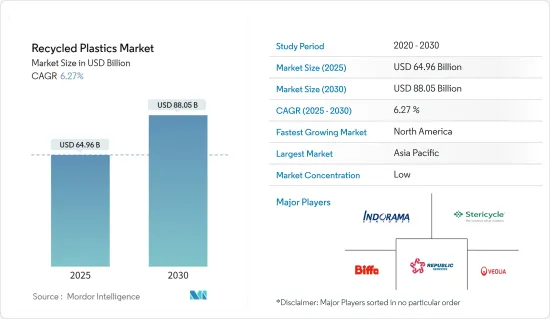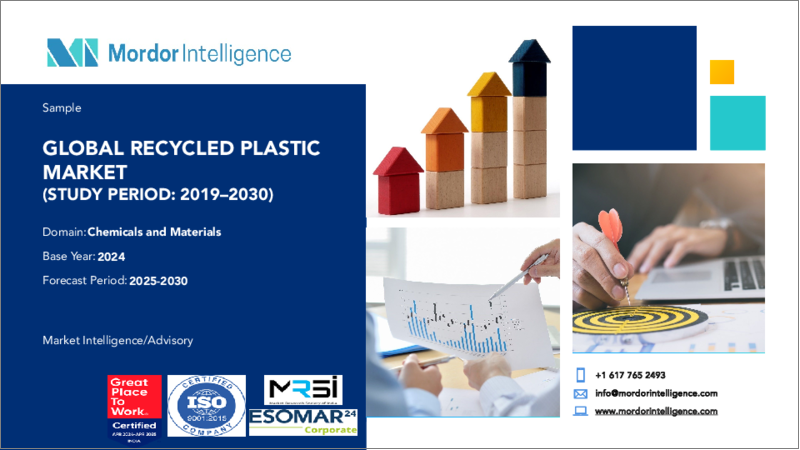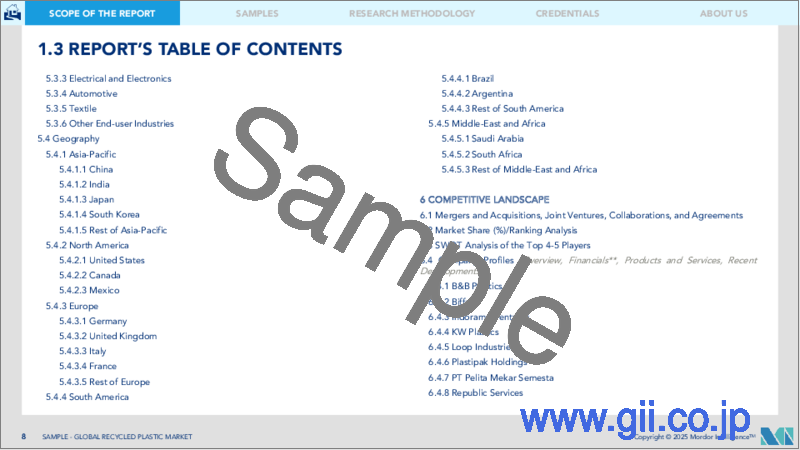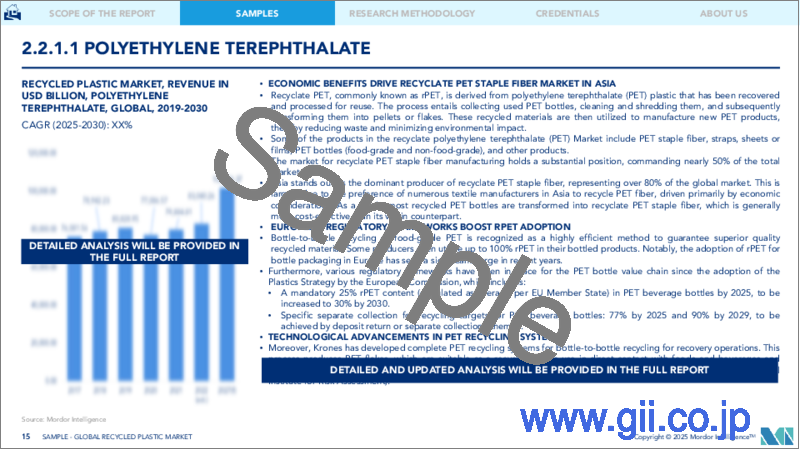|
|
市場調査レポート
商品コード
1636429
リサイクルプラスチック:市場シェア分析、産業動向と統計、成長予測(2025~2030年)Recycled Plastics - Market Share Analysis, Industry Trends & Statistics, Growth Forecasts (2025 - 2030) |
||||||
カスタマイズ可能
適宜更新あり
|
|||||||
| リサイクルプラスチック:市場シェア分析、産業動向と統計、成長予測(2025~2030年) |
|
出版日: 2025年01月05日
発行: Mordor Intelligence
ページ情報: 英文 150 Pages
納期: 2~3営業日
|
全表示
- 概要
- 目次
リサイクルプラスチックの市場規模は、2025年に649億6,000万米ドルと推定され、予測期間中(2025-2030年)のCAGRは6.27%で、2030年には880億5,000万米ドルに達すると予測されます。

リサイクルプラスチックは、廃プラスチックを有価物に再利用したものです。そのプロセスには、プラスチックの選別、洗浄、押し出し、再加工、識別が含まれます。非生分解性プラスチックの問題が世界的に広まる中、リサイクルはポリマーの環境蓄積と闘うための重要な解決策として際立っています。
リサイクルにおける技術の進歩は、リサイクルプラスチック市場を牽引する極めて重要な要素です。ケミカルリサイクルや選別方法の改善といった革新的な技術により、リサイクルプラスチックの効率と品質が大幅に向上しました。さらに、消費者が持続可能性をますます優先するようになるにつれ、自動車から消費財に至るまで、あらゆる業界のメーカーがリサイクル素材を採用するようになっています。この変化は、自動車部品、包装、家庭用品など、さまざまなアイテムの生産に顕著に表れています。こうした進歩と持続可能なソリューションへの需要の高まりにより、市場は今後数年で大きく成長する態勢を整えています。
リサイクルプラスチック市場の動向
包装業界におけるリサイクルプラスチックの採用増加
自動車、電気・電子、包装分野の主要企業は、リサイクルプラスチックへの関心を高めており、これらの材料の需要を牽引しています。これらの部門は、合計で毎年600万トン近くのプラスチック包装を消費しています。飲食品業界は、食品に安全な包装を求める最前線にあり、リサイクル可能なポリマーの使用を後押ししています。これらのポリマーは、包装用バリアとして採用された場合、食品の安全性を確保するだけでなく、従来のプラスチックに代わる持続可能な選択肢を提示することで、その市場範囲を拡大します。
再生ポリエチレンテレフタレート(PET)は、水や飲料のボトルを作るのに好ましい選択肢として際立っています。食用以外にも、再生ポリマーは玩具、ファッション・アクセサリー、スポーツ用品の包装に応用され、これらの商品の耐久性を高めています。また、その不活性な特性により、シャンプー、石鹸、界面活性剤などのパーソナルケア製品の包装需要も高まっています。消費財包装への採用が進むにつれ、リサイクルプラスチック市場はさらなる成長を遂げようとしています。
アジア太平洋地域におけるリサイクルプラスチック市場の成長
検討期間中、アジア太平洋地域は都市化、工業化、経済成長に後押しされ、リサイクルプラスチック市場をリードしました。同地域の工業セクターでは、自動車セクターの成長と建設における役割の拡大に支えられ、プラスチックの使用量が顕著に増加しました。インフラへの大規模な投資と住宅・商業施設の建設急増が、この動向をさらに後押ししました。
さらに、厳しい政府規制、環境問題の高まり、持続可能性を求める世界の動きが、リサイクルプラスチック採用の革新的ソリューションに拍車をかけています。例えば、インド政府はWWFインドとインド産業連盟の協力による「インドプラスチック協定」を導入し、UKリサーチ・アンド・イノベーション(UKRI)とWRAPがこれを支援しました。この協定は、100%再利用またはリサイクル可能なプラスチック包装への移行や、予測期間中にプラスチック包装の50%を効果的にリサイクルするなど、野心的な目標を目指しています。
リサイクルプラスチック業界の概要
リサイクルプラスチック市場は断片化されており、国内外に複数のプレーヤーが存在します。市場の主要企業は、研究開発センターへの投資、プラスチックリサイクル事業の拡大、存在感を高めるためのインフラ整備などの成長戦略に注力しています。主なプレーヤーには、Biffa、Stericycle、Republic Services、Veolia、Indorama Venturesなどがあります。
その他の特典:
- エクセル形式の市場予測(ME)シート
- 3ヶ月間のアナリスト・サポート
目次
第1章 イントロダクション
- 調査想定と市場定義
- 調査範囲
第2章 調査手法
第3章 エグゼクティブサマリー
第4章 市場力学と洞察
- 市場概要
- 市場促進要因
- 持続可能なプラスチック廃棄物管理に関する意識の高まり
- 埋め立て規制の実施
- 市場抑制要因
- リサイクルプラスチックよりもバージンプラスチックの優先順位
- 非効率なプラスチック廃棄物の分別と処分
- 市場機会
- 当局による規制がリサイクルプラスチックの採用を促進
- プラスチックリサイクル技術の進歩
- バリューチェーン分析
- 業界の魅力ポーターのファイブフォース分析
- 新規参入業者の脅威
- 買い手の交渉力
- 供給企業の交渉力
- 代替品の脅威
- 競争企業間の敵対関係
- 業界の技術的進歩に関する洞察
- COVID-19の市場への影響
第5章 市場セグメンテーション
- タイプ別
- ポリエチレン
- ポリ塩化ビニル
- ポリエチレンテレフタレート
- ポリプロピレン
- ポリスチレン
- その他
- 排出源別
- フォーム
- フィルム
- ボトル
- ファイバー
- その他
- エンドユーザー別
- 建築・建設
- 包装
- 電気・電子
- 自動車
- その他エンドユーザー
- 地域別
- 北米
- 米国
- カナダ
- その他北米
- 欧州
- 英国
- ドイツ
- フランス
- ロシア
- イタリア
- スペイン
- その他欧州
- アジア太平洋
- インド
- 中国
- 日本
- オーストラリア
- その他アジア太平洋地域
- 南米
- ブラジル
- アルゼンチン
- その他南米
- 中東・アフリカ
- アラブ首長国連邦
- 南アフリカ
- その他中東とアフリカ
- 北米
第6章 競合情勢
- 市場集中の概要
- 企業プロファイル
- Biffa
- Stericycle
- Republic Services
- Veolia
- Indorama Ventures
- Loop Industries
- Plastipak Holdings
- KW Plastics
- B&B Plastics
- Green Line Polymers*
第7章 市場動向
第8章 免責事項および出版社について
The Recycled Plastics Market size is estimated at USD 64.96 billion in 2025, and is expected to reach USD 88.05 billion by 2030, at a CAGR of 6.27% during the forecast period (2025-2030).

Recycled plastics are the result of repurposing waste plastic into valuable items. The process involves sorting, cleaning, extruding, reprocessing, and identifying the plastic. With the prevalent global issue of non-biodegradable plastics, recycling stands out as a crucial solution to combat the environmental accumulation of polymers.
Technological advancements in recycling are pivotal in driving the recycled plastics market. Innovations like chemical recycling and improved sorting methods have significantly boosted the efficiency and quality of recycled plastics. Moreover, as consumers increasingly prioritize sustainability, manufacturers across industries, from automotive to consumer goods, are adopting recycled materials. This shift is evident in the production of various items, including car parts, packaging, and household goods. With these advancements and the growing demand for sustainable solutions, the market is poised for substantial growth in the coming years.
Recycled Plastics Market Trends
Increasing Adoption of Recycled Plastic in Packaging Industries
Key players in the automotive, electrical and electronics, and packaging sectors are increasingly turning to recycled plastics, driving the demand for these materials. These sectors collectively consume close to 6 million tons of plastic packaging each year. The food and beverage industry is at the forefront of the push for food-safe packaging, propelling the use of recyclable polymers. These polymers, when employed as packaging barriers, not only ensure food safety but also present a sustainable option to traditional plastics, thereby expanding their market reach.
Recycled polyethylene terephthalate (PET) stands out as the preferred choice for crafting water and beverage bottles. Beyond edibles, recycled polymers are finding applications in packaging for toys, fashion accessories, and sports equipment, enhancing the durability of these items. Their inert characteristics are also driving the demand for packaging personal care products like shampoos, soaps, and surfactants. With their increasing adoption in consumer goods packaging, the market for recycled polymers is poised for further growth.
Rise in Recycled Plastics Market in Asia Pacific
During the review period, Asia-Pacific led the recycled plastics market, propelled by urbanization, industrialization, and economic growth. The region's industrial sector saw a notable uptick in plastic usage, supported by a growing automotive sector and an expanding role in construction. Significant investments in infrastructure, coupled with a surge in residential and commercial constructions, further bolstered this trend.
Additionally, stringent government regulations, rising environmental concerns, and a global push for sustainability have spurred innovative solutions in recycled plastic adoption. For instance, the Indian government introduced the 'India Plastics Pact,' a collaboration between WWF India and the Confederation of Indian Industry, and it was supported by UK Research and Innovation (UKRI) and WRAP. This pact aims for ambitious targets, including transitioning to 100% reusable or recyclable plastic packaging and effectively recycling 50% of plastic packaging during the forecast period.
Recycled Plastics Industry Overview
The recycled plastics market is fragmented, with the presence of several local and global players. Major players in the market are focusing on their growth strategies, such as investing in R&D centers, expansion of plastic recycling operations, and infrastructure development to strengthen their presence. Some of the major players include Biffa, Stericycle, Republic Services, Veolia, and Indorama Ventures.
Additional Benefits:
- The market estimate (ME) sheet in Excel format
- 3 months of analyst support
TABLE OF CONTENTS
1 INTRODUCTION
- 1.1 Study Assumption and Market Definition
- 1.2 Scope of the Study
2 RESEARCH METHODOLOGY
3 EXECUTIVE SUMMARY
4 MARKET DYNAMICS AND INSIGHTS
- 4.1 Market Overview
- 4.2 Market Drivers
- 4.2.1 Increasing Awareness Regarding Sustainable Plastic Waste Management
- 4.2.2 Implementation of Restrictions on Landfills
- 4.3 Market Restraints
- 4.3.1 Preference for Virgin Plastics Over Their Recycled Alternatives
- 4.3.2 Ineffective Plastic Waste Segregation and Disposal
- 4.4 Market Opportunities
- 4.4.1 Regulations Imposed by Authorities Promote the Adoption of Recycled Plastics
- 4.4.2 Advancements in Plastic Recycling Technologies
- 4.5 Value Chain Analysis
- 4.6 Industry Attractiveness: Porter's Five Forces Analysis
- 4.6.1 Threat of New Entrants
- 4.6.2 Bargaining Power of Buyers
- 4.6.3 Bargaining Power of Suppliers
- 4.6.4 Threat of Substitutes
- 4.6.5 Intensity of Competitive Rivalry
- 4.7 Insights into Technological Advancements in the Industry
- 4.8 Impact of COVID-19 on the Market
5 MARKET SEGMENTATION
- 5.1 By Type
- 5.1.1 Polyethylene
- 5.1.2 Polyvinyl Chloride
- 5.1.3 Polyethylene Terephthalate
- 5.1.4 Polypropylene
- 5.1.5 Polystyrene
- 5.1.6 Other Types
- 5.2 By Source
- 5.2.1 Foams
- 5.2.2 Films
- 5.2.3 Bottles
- 5.2.4 Fibers
- 5.2.5 Other Sources
- 5.3 By End User
- 5.3.1 Building and Construction
- 5.3.2 Packaging
- 5.3.3 Electrical and Electronics
- 5.3.4 Automotive
- 5.3.5 Other End Users
- 5.4 By Geography
- 5.4.1 North America
- 5.4.1.1 United States
- 5.4.1.2 Canada
- 5.4.1.3 Rest of North America
- 5.4.2 Europe
- 5.4.2.1 United Kingdom
- 5.4.2.2 Germany
- 5.4.2.3 France
- 5.4.2.4 Russia
- 5.4.2.5 Italy
- 5.4.2.6 Spain
- 5.4.2.7 Rest of Europe
- 5.4.3 Asia-Pacific
- 5.4.3.1 India
- 5.4.3.2 China
- 5.4.3.3 Japan
- 5.4.3.4 Australia
- 5.4.3.5 Rest of Asia-Pacific
- 5.4.4 South America
- 5.4.4.1 Brazil
- 5.4.4.2 Argentina
- 5.4.4.3 Rest of South America
- 5.4.5 Middle East and Africa
- 5.4.5.1 United Arab Emirates
- 5.4.5.2 South Africa
- 5.4.5.3 Rest of Middle East and Africa
- 5.4.1 North America
6 COMPETITIVE LANDSCAPE
- 6.1 Market Concentration Overview
- 6.2 Company Profiles
- 6.2.1 Biffa
- 6.2.2 Stericycle
- 6.2.3 Republic Services
- 6.2.4 Veolia
- 6.2.5 Indorama Ventures
- 6.2.6 Loop Industries
- 6.2.7 Plastipak Holdings
- 6.2.8 KW Plastics
- 6.2.9 B&B Plastics
- 6.2.10 Green Line Polymers*





